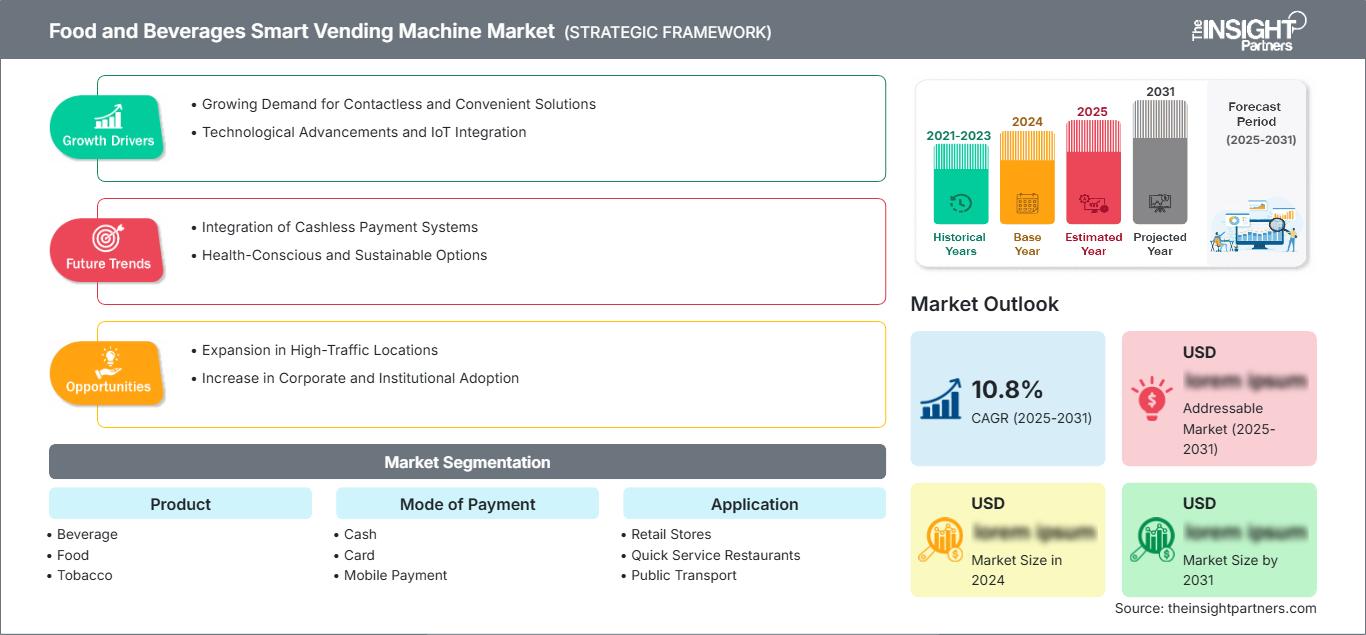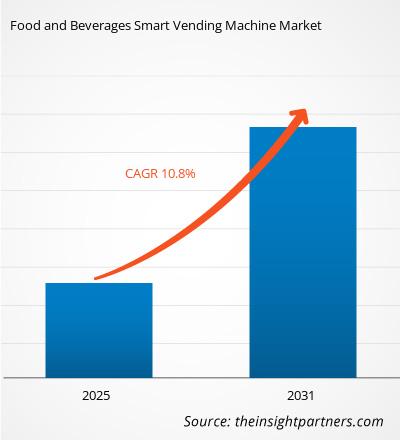Se prevé que el mercado de máquinas expendedoras inteligentes de alimentos y bebidas registre una tasa de crecimiento anual compuesta (CAGR) del 10,8% entre 2025 y 2031, con un tamaño de mercado que se expandirá de XX millones de dólares estadounidenses en 2024 a XX millones de dólares estadounidenses en 2031.
El informe se segmenta por producto (bebidas, alimentos, tabaco y otros), forma de pago (efectivo, tarjeta (débito/crédito) y pago móvil) y aplicación (tiendas minoristas, restaurantes de comida rápida, transporte público, centros de negocios y otros). El análisis global se desglosa aún más a nivel regional y por países principales. El informe ofrece el valor en USD para el análisis y los segmentos mencionados.
Propósito del Informe
El informe «Mercado de máquinas expendedoras inteligentes de alimentos y bebidas», elaborado por The Insight Partners, tiene como objetivo describir el panorama actual y el crecimiento futuro, los principales factores impulsores, los desafíos y las oportunidades. Esto proporcionará información valiosa a diversos actores del sector, tales como:
- Proveedores/fabricantes de tecnología: Para comprender la dinámica cambiante del mercado y conocer las oportunidades potenciales de crecimiento, lo que les permitirá tomar decisiones estratégicas informadas.
- Inversores: Realizar un análisis exhaustivo de las tendencias relativas a la tasa de crecimiento del mercado, las proyecciones financieras del mercado y las oportunidades que existen a lo largo de la cadena de valor.
- Organismos reguladores: Regular las políticas y controlar las actividades en el mercado con el objetivo de minimizar los abusos, preservar la confianza de los inversores y mantener la integridad y la estabilidad del mercado.
Segmentación del mercado de máquinas expendedoras inteligentes de alimentos y bebidas
Producto
- Bebida
- Alimento
- Tabaco
- Otros
Forma de pago
- Dinero
- Tarjeta
- Pago móvil
Solicitud
- Tiendas minoristas
- Restaurantes de servicio rápido
- Transporte público
- Centro de negocios
- Otros
Geografía
- América del norte
- Europa
- Asia-Pacífico
- América del Sur y Central
- Oriente Medio y África
Obtendrá personalización en cualquier informe, sin cargo, incluidas partes de este informe o análisis a nivel de país, paquete de datos de Excel, así como también grandes ofertas y descuentos para empresas emergentes y universidades.
Mercado de máquinas expendedoras inteligentes de alimentos y bebidas: Perspectivas estratégicas

-
Obtenga las principales tendencias clave del mercado de este informe.Esta muestra GRATUITA incluirá análisis de datos, desde tendencias del mercado hasta estimaciones y pronósticos.
Factores que impulsan el crecimiento del mercado de máquinas expendedoras inteligentes de alimentos y bebidas
- Creciente demanda de soluciones sin contacto y convenientes: La creciente demanda de soluciones de autoservicio sin contacto impulsa significativamente el mercado de máquinas expendedoras inteligentes de alimentos y bebidas. Estas máquinas, equipadas con interfaces digitales y opciones de pago sin efectivo, ofrecen una forma cómoda e higiénica para que los consumidores adquieran alimentos y bebidas, especialmente tras la pandemia. A medida que los consumidores priorizan la seguridad y la comodidad, el mercado de máquinas expendedoras inteligentes continúa creciendo.
- Avances tecnológicos e integración del IoT: La integración de la tecnología del Internet de las Cosas (IoT) en las máquinas expendedoras inteligentes está impulsando su adopción. Gracias al IoT, estas máquinas pueden proporcionar datos en tiempo real sobre el inventario, realizar un seguimiento de las ventas y enviar alertas para reabastecer, realizar mantenimiento o controlar la temperatura. Estos avances mejoran la eficiencia operativa de las máquinas expendedoras, lo que se traduce en una mayor fiabilidad y satisfacción del cliente, impulsando aún más el crecimiento del mercado.
Tendencias futuras del mercado de máquinas expendedoras inteligentes de alimentos y bebidas
- Integración de sistemas de pago sin efectivo: Una de las principales tendencias en el mercado de máquinas expendedoras inteligentes de alimentos y bebidas es la creciente integración de sistemas de pago sin efectivo, como monederos móviles, tarjetas de crédito y escaneo de códigos QR. Esta tendencia se debe a la creciente adopción de métodos de pago digitales y a la demanda de transacciones más rápidas, seguras y convenientes. Los sistemas sin efectivo también reducen el riesgo de fraude y mejoran la eficiencia de las transacciones, convirtiéndose así en una característica estándar de las máquinas expendedoras inteligentes.
- Opciones saludables y sostenibles: Los consumidores buscan cada vez más opciones saludables y sostenibles en alimentos y bebidas, y esta tendencia se refleja en el mercado de las máquinas expendedoras inteligentes. Estas máquinas se están equipando con opciones como snacks orgánicos, ensaladas frescas, bebidas bajas en calorías y envases ecológicos. La creciente conciencia sobre la salud y la sostenibilidad está impulsando a los operadores de máquinas expendedoras a actualizar su oferta, adaptándola a las preferencias de los consumidores por opciones nutritivas y respetuosas con el medio ambiente.
Oportunidades de mercado para máquinas expendedoras inteligentes de alimentos y bebidas
- Expansión en zonas de alta afluencia: Existe una importante oportunidad para el crecimiento de las máquinas expendedoras inteligentes en zonas de alta afluencia como aeropuertos, centros comerciales, hospitales y edificios de oficinas. Estas áreas representan una amplia base de consumidores, ideal para ofrecer una gran variedad de alimentos y bebidas a través de máquinas expendedoras convenientes, disponibles las 24 horas. La creciente demanda de soluciones de comida rápida para llevar en estos lugares ofrece una excelente oportunidad para la implementación de máquinas expendedoras inteligentes.
- Aumento de la adopción corporativa e institucional: Numerosas empresas e instituciones educativas están invirtiendo en máquinas expendedoras inteligentes para ofrecer a empleados y estudiantes opciones de alimentos y bebidas más saludables, además de mayor comodidad. Las máquinas expendedoras inteligentes en oficinas corporativas, universidades e instituciones gubernamentales pueden equiparse con funciones personalizadas y opciones de productos más saludables, lo que las convierte en una alternativa atractiva para estos sectores. Este creciente interés representa una oportunidad para que los fabricantes se dirijan a clientes institucionales y corporativos.
Perspectivas regionales del mercado de máquinas expendedoras inteligentes de alimentos y bebidas
Los analistas de The Insight Partners han explicado en detalle las tendencias regionales y los factores que influyen en el mercado de máquinas expendedoras inteligentes de alimentos y bebidas durante el período de previsión. Esta sección también analiza los segmentos y la geografía del mercado de máquinas expendedoras inteligentes de alimentos y bebidas en Norteamérica, Europa, Asia Pacífico, Oriente Medio y África, y Sudamérica y Centroamérica.
Alcance del informe de mercado sobre máquinas expendedoras inteligentes de alimentos y bebidas
| Atributo del informe | Detalles |
|---|---|
| Tamaño del mercado en 2024 | XX millones de dólares estadounidenses |
| Tamaño del mercado en 2031 | XX millones de dólares estadounidenses |
| CAGR global (2025-2031) | 10,8% |
| Datos históricos | 2021-2023 |
| período de previsión | 2025-2031 |
| Segmentos cubiertos |
Por producto
|
| Regiones y países cubiertos |
América del norte
|
| Líderes del mercado y perfiles de empresas clave |
|
Densidad de los actores del mercado de máquinas expendedoras inteligentes de alimentos y bebidas: comprensión de su impacto en la dinámica empresarial.
El mercado de máquinas expendedoras inteligentes de alimentos y bebidas está creciendo rápidamente, impulsado por la creciente demanda de los usuarios finales debido a factores como la evolución de las preferencias de los consumidores, los avances tecnológicos y una mayor conciencia de los beneficios del producto. A medida que aumenta la demanda, las empresas amplían su oferta, innovan para satisfacer las necesidades de los consumidores y aprovechan las nuevas tendencias, lo que impulsa aún más el crecimiento del mercado.

- Obtenga una visión general de los principales actores del mercado de máquinas expendedoras inteligentes de alimentos y bebidas.
Puntos clave de venta
- Cobertura integral: El informe abarca de forma exhaustiva el análisis de productos, servicios, tipos y usuarios finales del mercado de máquinas expendedoras inteligentes de alimentos y bebidas, proporcionando una visión holística.
- Análisis de expertos: El informe se elabora a partir del profundo conocimiento de expertos y analistas del sector.
- Información actualizada: El informe asegura relevancia comercial debido a su cobertura de información reciente y tendencias de datos.
- Opciones de personalización: Este informe se puede personalizar para satisfacer las necesidades específicas del cliente y adaptarse adecuadamente a las estrategias comerciales.
Por lo tanto, el informe de investigación sobre el mercado de máquinas expendedoras inteligentes de alimentos y bebidas puede ayudar a liderar el proceso de análisis y comprensión del panorama de la industria y sus perspectivas de crecimiento. Si bien existen algunas preocupaciones válidas, los beneficios generales de este informe tienden a superar las desventajas.
- Análisis histórico (2 años), año base, pronóstico (7 años) con CAGR
- Análisis PEST y FODA
- Tamaño del mercado, valor/volumen: global, regional y nacional
- Industria y panorama competitivo
- Conjunto de datos de Excel
Informes recientes
Informes relacionados
Testimonios
Razón para comprar
- Toma de decisiones informada
- Comprensión de la dinámica del mercado
- Análisis competitivo
- Información sobre clientes
- Pronósticos del mercado
- Mitigación de riesgos
- Planificación estratégica
- Justificación de la inversión
- Identificación de mercados emergentes
- Mejora de las estrategias de marketing
- Impulso de la eficiencia operativa
- Alineación con las tendencias regulatorias






















 Obtenga una muestra gratuita para - Mercado de máquinas expendedoras inteligentes de alimentos y bebidas
Obtenga una muestra gratuita para - Mercado de máquinas expendedoras inteligentes de alimentos y bebidas